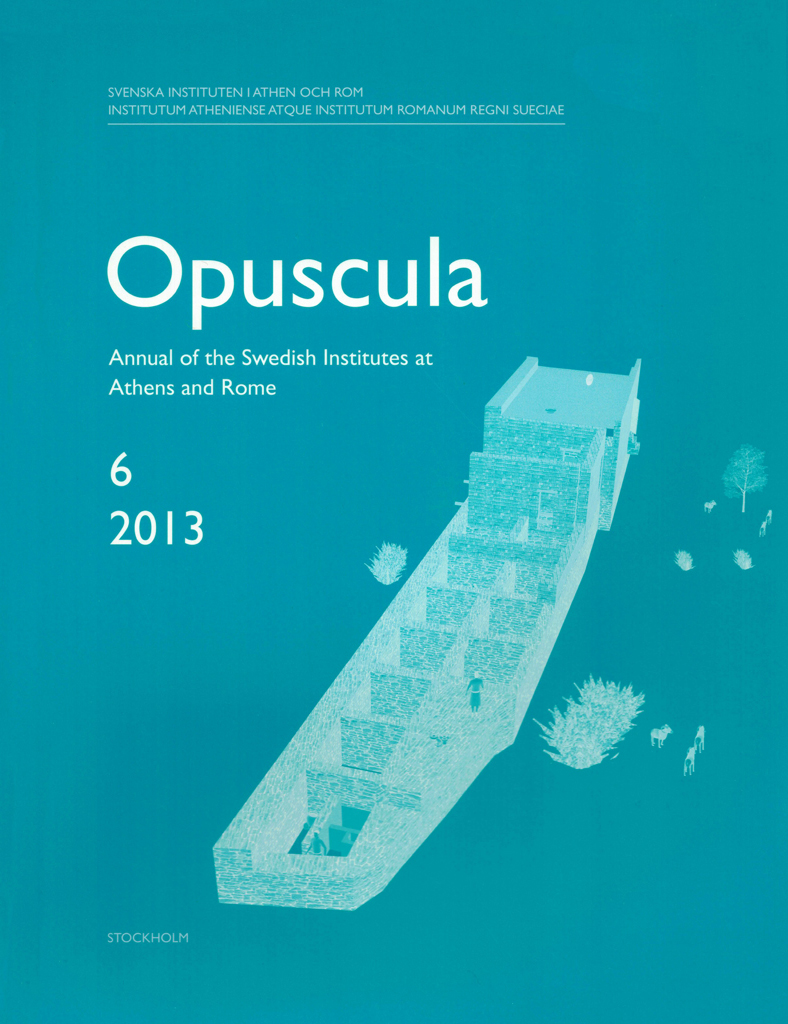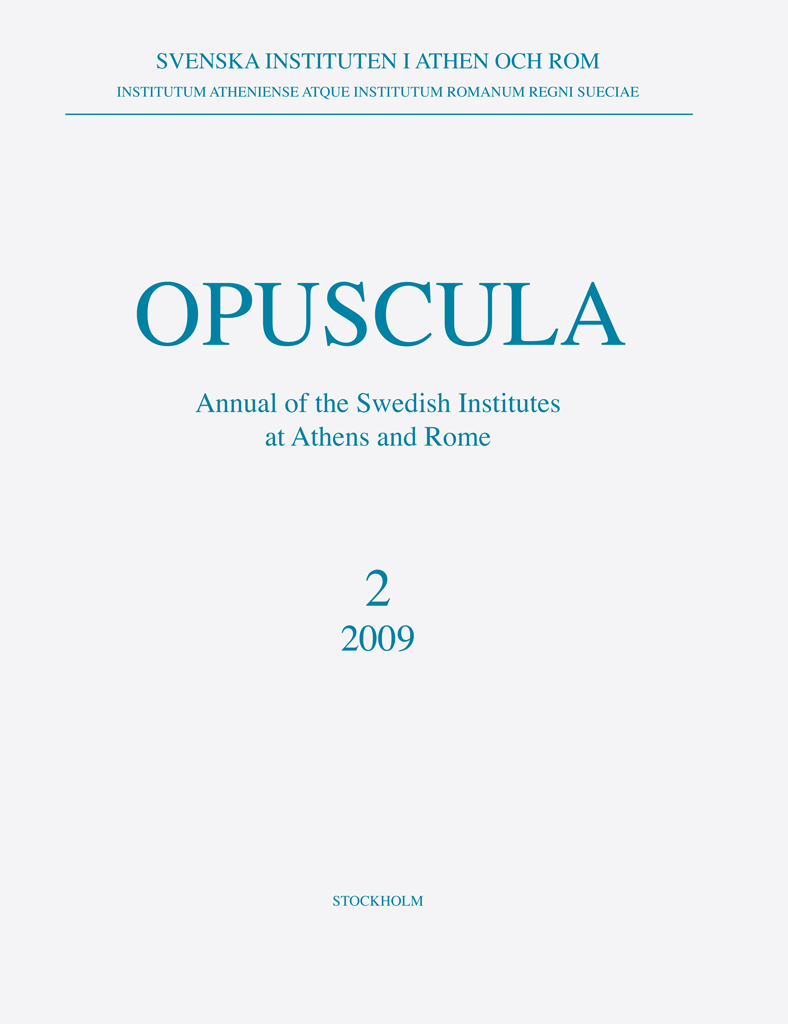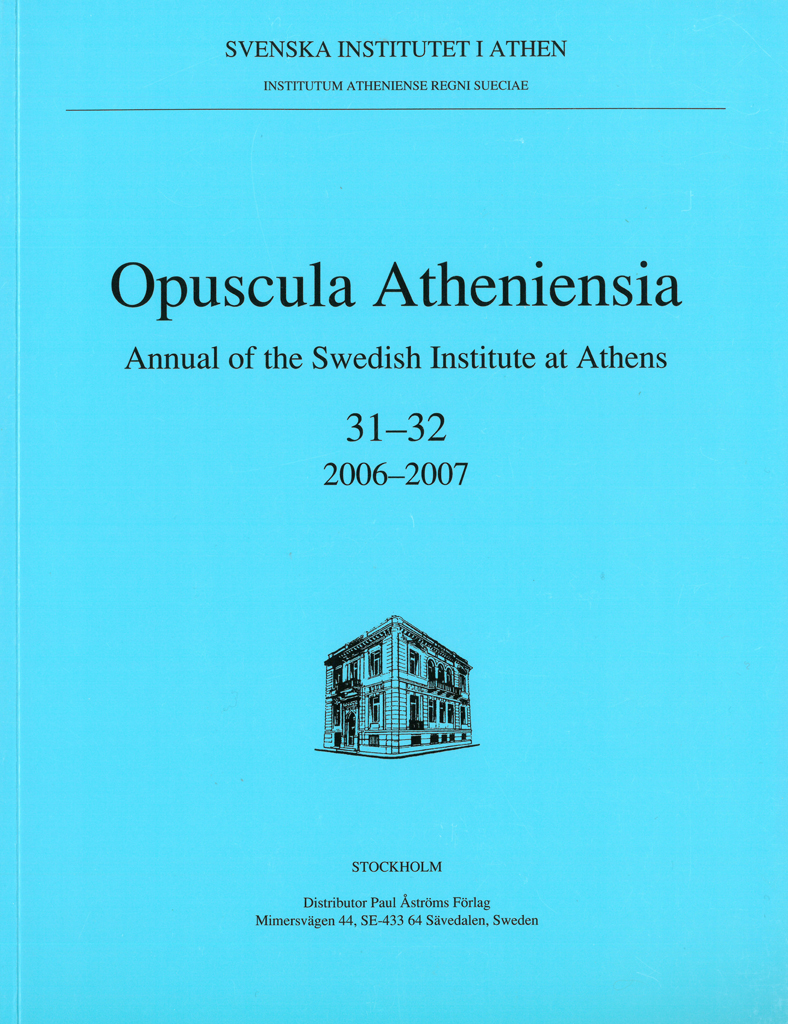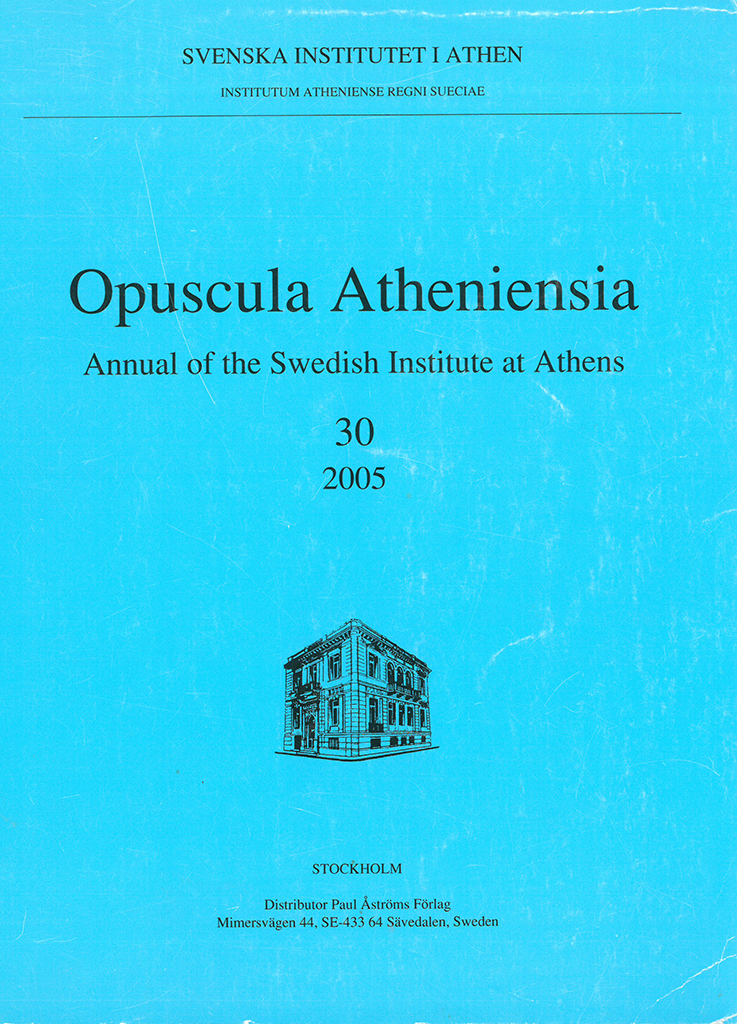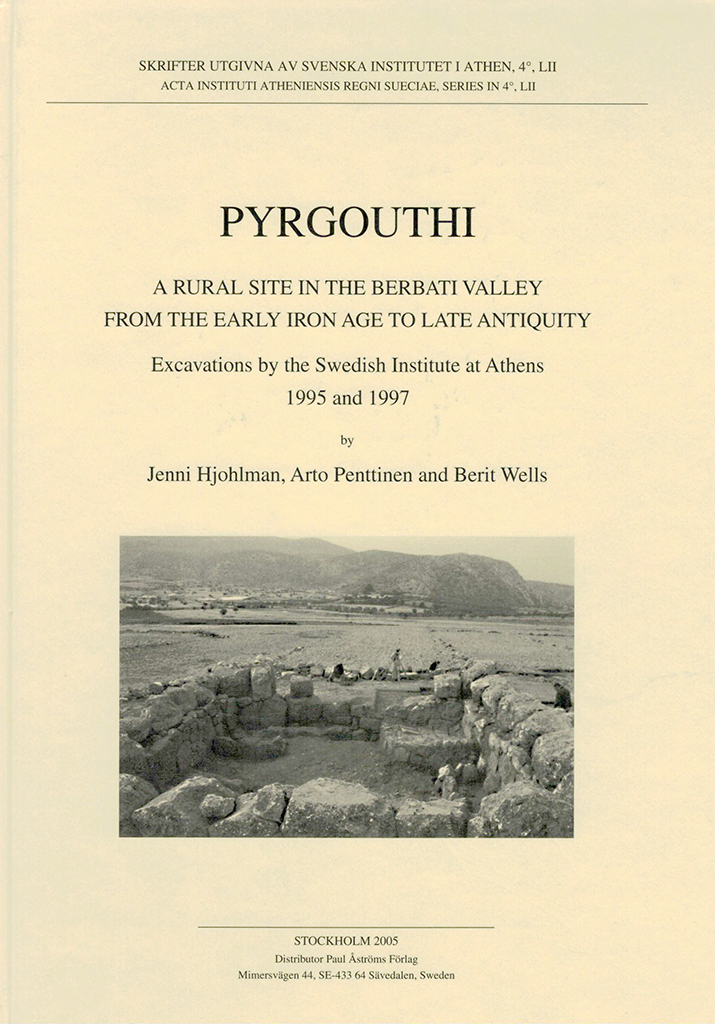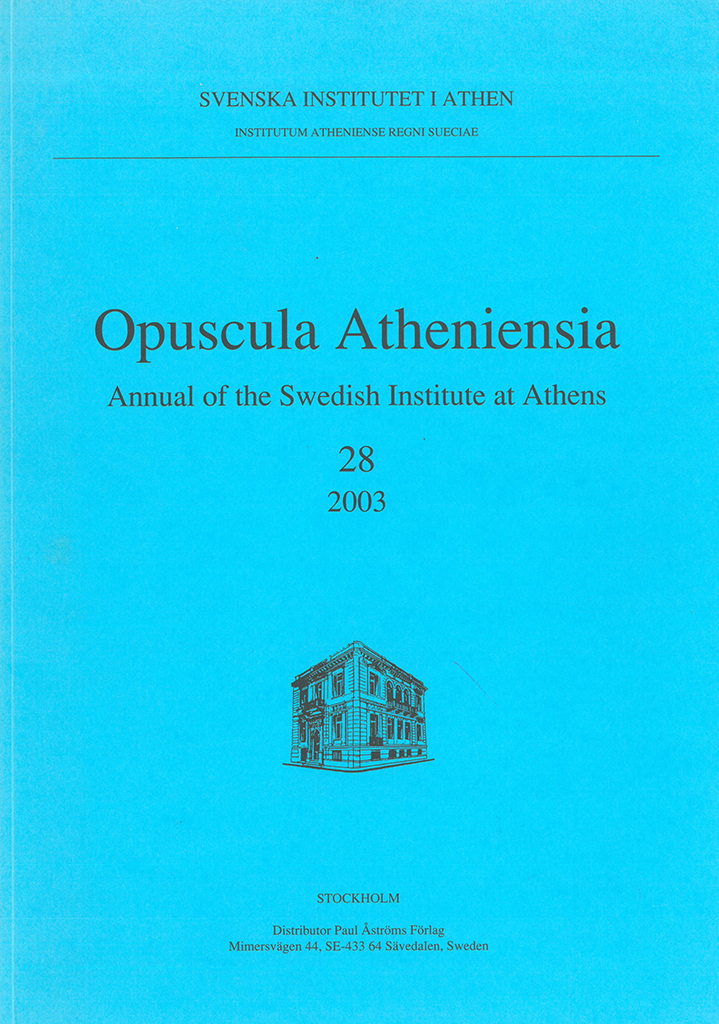Opuscula is published by the Swedish Institutes at Athens and Rome, with the aid of a grant from the Swedish Research Council. Distributed by Eddy.se AB. View journal at ERIH PLUS. All content available with open access. The Kalaureia Excavation Project. A preliminary report of the work carried out in Area L between 2015 and 2018 By Anton Bonnier (Uppsala University, Sweden), Therese Emanuelsson-Paulson (Stockholm University, Sweden), Dimitra Mylona (INSTAP Study Center for East Crete, Greece) & Arto Penttinen (Swedish Institute at Athens, Greece) Abstract The report presents a summary and preliminary discussion on the work carried out by the Swedish Institute at ancient Kalaureia between 2015 and 2018 in Area L. The excavations were focused on this area with the hopes of gaining a better understanding of the settlement which was situated south of the Sanctuary of Poseidon in antiquity. The excavations show that a large building was constructed probably around the middle of the 4th century BC in the western part of Area L. The full outline and functional use of the building has not yet been fully established but the building seems to have been in use in several subsequent phases. The excavated remains further suggest that…
Opuscula is published by the Swedish Institutes at Athens and Rome, with the aid of a grant from the Swedish Research Council. Distributed by Eddy.se AB. View journal at ERIH PLUS. All content available with open access. Physical environment and daily life in the Sanctuary of Poseidon at Kalaureia, Poros. The bioarchaeological remains By Arto Penttinen (Swedish Institute at Athens, Greece) & Dimitra Mylona (INSTAP Study Center for East Crete, Greece) Abstract The section below contains reports on bioarchaeological remains recovered in the excavations in Areas D and C in the Sanctuary of Poseidon at Kalaureia, Poros, between 2003 and 2005. The excavations were directed by the late Berit Wells within a research project named Physical Environment and Daily Life in the Sanctuary of Poseidon at Kalaureia (Poros). The main objective of the project was to study what changed and what remained constant over time in the everyday life and in both the built and physical environment in an important sanctuary of the ancient Greeks. The bioarchaeological remains, of a crucial importance for this type of study, were collected both by means of traditional archaeological excavation and by processing extensively collected soil samples. This text aims to providing the theoretical…
Opuscula is published by the Swedish Institutes at Athens and Rome, with the aid of a grant from the Swedish Research Council. Distributed by Eddy.se AB. View journal at ERIH PLUS. All content available with open access. Berit Wells in Memoriam By Arto Penttinen & Jenny Wallensten Introduction The following section honours our colleague, teacher, and friend, Berit Wells. The contributions were originally to be included in a Festschrift, which we wished to present to Berit on her 67th birthday. Sadly, Berit lost her battle against cancer before we could finish the volume. We thus decided to transform the Festschrift into a conference dedicated to her memory, and this event took place over two cold winter days in December 2009. For the Festschrift we had chosen two themes: religion and food production in the ancient Greek world. The interface of these very broad themes seemed to us to converge and offer an overall perspective of Berit’s research and simultaneously, they allowed colleagues from all stages of Berit’s careers to take part and contribute to the conference. The six articles included in Opuscula 2014 are a selection of the conference papers, which also included reports from the Poros excavations. Poros was…
Opuscula is published by the Swedish Institutes at Athens and Rome, with the aid of a grant from the Swedish Research Council. Distributed by Eddy.se AB. View journal at ERIH PLUS. All content available with open access. The Makrakomi Archaeological Landscapes Project (MALP). A preliminary report on investigations carried out in 2010–2012 By Maria-Foteini Papakonstantinou, Arto Penttinen, Gregory N. Tsokas, Panagiotis I. Tsourlos, Alexandros Stampolidis, Ilias Fikos, Georgios Tassis, Konstantina Psarogianni, Lambros Stavrogiannis, Anton Bonnier, Monica Nilsson & Henrik Boman Abstract In this article we provide a preliminary report of the work carried out between 2010 and 2012 as part of the Makrakomi Archaeological Landscapes Project (MALP). The programme of research is carried out in co-operation between the Swedish Institute at Athens and the 14th Ephorate of Prehistoric and Classical Antiquities at Lamia. The interdisciplinary project started in the summer of 2010, when a pilot survey was conducted in and around the hill of Profitis Elias, in the modern municipality of Makrakomi, where extensive traces of ancient fortifications are still visible. Systematic investigations have been conducted since 2011 as part of a five-year plan of research involving surface survey, geophysical survey and small-scale archaeological excavation as well as geomorphological investigation….
Published by the Swedish Institute at Athens. Distributed by Eddy.se AB. All content is available with open access, use links below. Mastos in the Berbati Valley. An intensive archaeological survey Edited by Michael Lindblom & Berit Wells Abstract This study presents the results of a small but intensive surface survey conducted on the Mastos Hill in the Berbati Valley in 1999. While remains from the Early and Late Helladic period were known from previous excavations on its southern and eastern slopes, this is the first analysis of the entire hill. It includes a digital documentation of the local topography as well as an account of the archaeological remains retrieved in the field. The study fills a gap in different data sets and results gained through old excavations and the extensive 1988–1990 Berbati-Limnes survey. The introductory chapter summarizes previous work in the valley, discusses its ancient routes of communication and outlines the method employed in the archaeological survey. This is followed by an account of the topographical survey and the geographical information system used. In the six following chapters the archaeological remains are presented and analyzed in a diachronic fashion. It is concluded that the hill was predominantely settled in prehistory…
Opuscula is published by the Swedish Institutes at Athens and Rome, with the aid of a grant from the Swedish Research Council. Distributed by Eddy.se AB. View journal at ERIH PLUS. All content available with open access. Report on the excavations in the years 2007 and 2008 southeast of the Temple of Poseidon at Kalaureia By Arto Penttinen and Berit Wells (†). With contributions by Dimitra Mylona, Petra Pakkanen, Jari Pakkanen, Arja Karivieri, Anne Hooton and Emanuel Savini, and with an appendix by Tatiana Theodoropoulou. Abstract Archaeological material ranging in date from the Early Bronze Age to Late Antiquity was found in 2007 and 2008 in the excavations in Area H to the south and southeast of the Temple of Poseidon. Finds datable to the periods of major change in the Sanctuary—the Late Archaic and the Early Hellenistic—illuminate the character of the change. In the Late Archaic period an attempt to erect a votive column at the site was for some reason given up, and drums of large dimensions were left visible, possibly as a reminder of the failure. The construction of a monumental drain next to the Archaic peribolos of the Temple of Poseidon in the early third century…
Published by the Swedish Institute at Athens. Distributed by Eddy.se AB. Opuscula Atheniensia. Annual of the Swedish Institute at Athens 31–32, 2006–2007 Contents Katie Demakopoulou, Nicoletta Divari-Valakou, Monica Nilsson & Ann-Louise –Schallin, ‘Excavations in Midea 2005’, pp. 7–29. Berit Wells, Arto Penttinen & Jenni Hjohlman, with contributions by Kristian Göransson, Arja Karivieri & Maria Daniela Trifirò, ‘The Kalaureia Excavation Project. The 2004 and 2005 seasons’, pp. 31–129. Mats Johnson, ‘Early farming in the land of springs. Settlement patterns and agriculture in Neolithic Greece’, pp. 131–170. Mercourios Georgiadis & Chrysanthi Gallou, ‘The cemeteries of the Argolid and the south-eastern Aegean during the Mycenaean period. A landscape and waterscape assessment’, pp. 171–182. Helène Whittaker, ‘Burnt animal sacrifice in Mycenaean cult. A review of the evidence’, pp. 183–190. David S. Reese, ‘Organic imports from Late Bronze Age Cyprus (with special reference to Hala Sultan Tekke)’, pp. 191–209. Helen Mangou, Michalis Petropoulos, Alexander Gasparatos, Elias Tsakmakis & Panayiotis V. Ioannou, ‘The temple of Artemis (F)aontia, at Rakita, Achaia, Greece. Chemical compositions of metal and glass votives’, pp. 211–220. Lena Sjögren, ‘The Eteocretans. Ancient traditions and modern constructions of ethnic identity’, pp. 221–230. Jesper Blid, ‘New research on Carian Labraunda in Late Antiquity’, pp. 231–255….
Published by the Swedish Institute at Athens. Distributed by Astrom Editions. Opuscula Atheniensia. Annual of the Swedish Institute at Athens 30, 2005 Contents Katie Demakopoulou, Nicoletta Divari-Valakou, Ann-Louise Schallin, Lena Sjögren & Monica Nilsson | Excavations in Midea 2004 (pp. 7-34) Sandrine Ducaté-Paarmann | Images de la grossesse en Grèce ancienne: réflexions sur les modes de pensées et de comportements à l’égard du corps enceint (pp. 35-53) Johan Flemberg | A female canon: addenda (pp. 55-59) Niklas Hillbom | Minoan game markers, pieces and dice. Small archaeological finds that could have belonged to games and gaming (pp. 61-98) Eleni Mantzourani & Giorgos Vavouranakis | Achladia and Epano Zakros: a re-examination of the architecture and topography of two possible Minoan villas in east Crete (pp. 99-125) Berit Wells, Arto Penttinen, Jenni Hjohlman & Emanuel Savini | The Kalaureia Excavation Project: the 2003 season, with an appendix by Kristian Göransson (pp. 127-215) Book reviews Jeannette Forsén | S.L. Petrakis, Ayioryitika. The 1928 excavations of Carl Blegen at a Neolithic to Early Helladic settlement in Arcadia (pp. 217-218) Izabella Donkow | D. Parrish (ed.), Urbanism in Western Asia Minor: new studies on Aphrodisias, Ephesos, Hierapolis, Pergamon, Perge and Xanthos (pp. 218-221) Bibliographical information…
Published by the Swedish Institute at Athens. Distributed by Astrom Editions. Pyrgouthi. A rural site in the Berbati Valley from the Early Iron Age to Late Antiquity. Excavations by the Swedish Institute at Athens 1995 and 1997 By Jenni Hjohlman, Arto Penttinen & Berit Wells, with contributions by Yannis Bassiakos, Katie Theodorakopoulou, Hero Granger-Taylor, Sven Isaksson, Petros Lymberakis, Dimitra Mylona, Maria Ntinou, Anaya Sarpaki & George Syrides Abstract This volume presents the results of the excavations in 1995 and 1997 at Pyrgouthi in the Berbati Valley, Argolis, Greece. The toponym is the local denomination for a Hellenistic tower, which has always been a prominent in the landscape. In the surface survey of the valley in 1988–1990 the tower was perceived as part of a Classical farmstead and in the ensuing excavation project it was targeted as such. However, the excavations revealed that this interpretation corresponded to but a fraction of the truth. The tower had been built on a knoll in the center of the valley but the earliest human activities at the site can be dated to the end of the Early Iron Age or the eight century BC. At this point in time, Arto Penttinen argues, the archaeological…
Published by the Swedish Institute at Athens. Distributed by Astrom Editions. Opuscula Atheniensia. Annual of the Swedish Institute at Athens 28, 2003 Contents Katie Demakopoulou, Nicoletta Divari-Valakou & Ann-Louise Schallin | Excavations in Midea 2002 (pp. 7-28) Berit Wells, Arto Penttinen & Marie Françoise Billot | Investigations in the sanctuary of Poseidon on Kalaureia 1997-2001 (pp. 29-87) Charles M. Adelman | The find group pottery from the Swedish excavations at Sina, Cyprus: significant sherds selected by Arne Furumark for his working notebook (pp. 89-171) Robert Parker | The problem of the Greek cult epithet (pp. 173-183) Birgitta L. Sjöberg | Settlement activity at Late Helladic Asine in the Argolid (pp. 185-201) Book reviews Lyvia Morgan | N. Marinatos, The Goddess and the Warrior. The naked goddess and Mistress of Animals in early Greek religion (pp. 203-204) Gunnel Ekroth | M. Deoudi, Heroenkulte in homerischer Zeit (pp. 204-207) Björn Forsén | Y.A. Pikoulas, Αρκαδια. Συλλογὴ μελετών (pp. 207-208) Björn Forsén | Y.A. Pikoulas, Λεξικό των οικισμών της Πελοποννήσου: παλαιά και νέα τοπωνύμια & F.A. Cooper (ed.), Houses of the Morea. Vernacular architecture of the northwest Peloponnesos (1205-1955) (pp. 209-210) Izabella Donkow | V. Tatton-Brown (ed.), Cyprus in the 19th century AD:…




